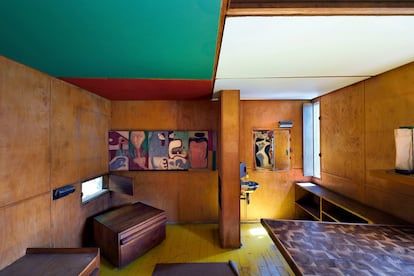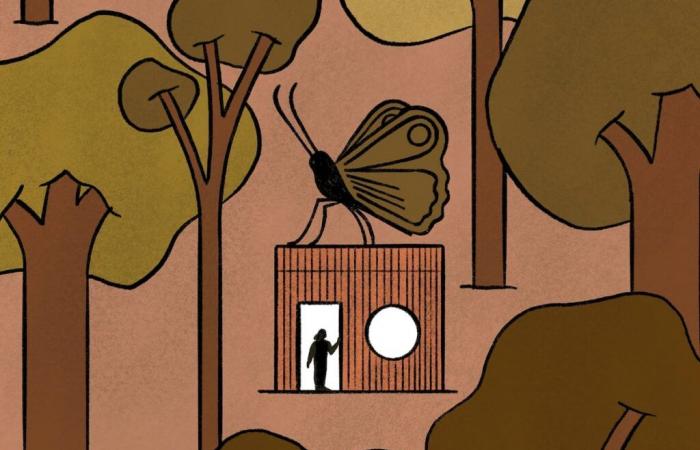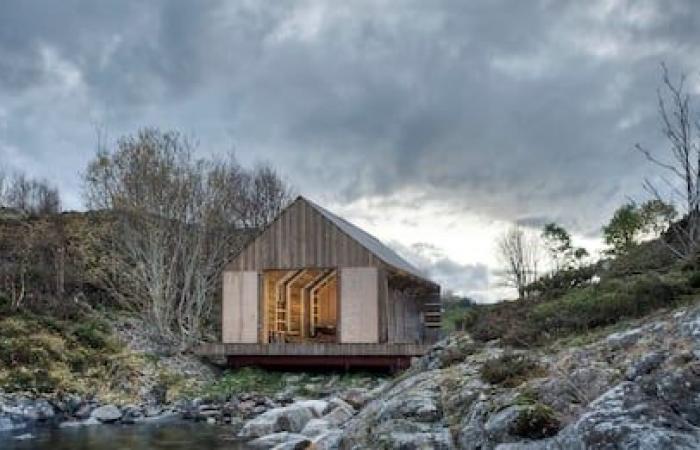The shelters are associated with two almost antagonistic concepts: survival – during a natural war or catastrophe – and emotional rebirth, another type of survival. Both situations have in common a break, the arrest of almost everything – except time, of course – and a change of life, temporary or decisive. Also a detachment of the material and a demand for the essentials derived from the flight or the search for greater introspection.
At one time when there are more than 43 million refugees in the world, despair to survive from that part of the population contrasts with the need to depart from the world that feels a good part of the other. Although they might seem that they have distant starting points, it is not a opposite emergencies. Refugee blankets, their temporary habitats, represent the domestication of survival, when, finally, they manage to stop their flight in a camp that welcomes them. As small cities, those fields, in Sudan, Kenya, Greece or Jordan, sometimes exceed 15,000 inhabitants. They are, therefore, cities not so of course – the average permanence according to UNHCR ranges between 10 and 15 years. Those times turn the fields, and the shelters themselves, into places of transformation as well as survival. Thus, although it is born of incomparably distant motifs, it is also that extreme metamorphosis that seeks in shelters who, paradoxically, does not have to survive more than itself, a duel, bad gusts or a series of wrong decisions.
In the insulation for self -knowledge, San Jerónimo was a pioneer – who lived with the only company of a lion, who had tamed heating the wounds (what a beautiful lesson) -. But the one who wrote the most famous about the distancing of the worldly noise, that is to say about the refuge of nature, was Henry David Thoreau. He did it in the mid -nineteenth century, after moving to a wooden cabin that he had built next to Lake Walden, not far from Concord, in Massachusetts.
Son of a family who earned a living by manufacturing pencils, Thoreau studied philosophy and sciences in Harvard, but, finished his studies, he did not want to pay for the parchment with the title. It was his first act of civil disobedience. Or of freedom. He was 28 when, after founding his own school, working as a tutor for the children of Ralph Waldo Emerson and, above all, after the sudden death of his brother – who infected tetanus with an oxidized shaving knife -, he decided to move to the forest to “avoid discovering at the time of death that he had not lived”. Surrounded by nature, I wanted to extract the medulla from life: a Spartan experience that would take it away from any non -essential distraction.
He stayed there two years, two months and two days. And he learned that “man is rich in proportion to the amount of things he can do without.” In Walden he wrote that there were three chairs in his house: one for loneliness, two for friendship and three for society. That same spirit, of the discovery of nature – and of reunion with oneself -, of dispossession of the superfluous and of searching for a truth, has led many people to seek a refuge, physical and psychic. And many architects to work the idea of the indispensable.
In the Nordic countries, the cabin in which to isolate for a few days replaces the second residence that, in the twentieth century, became popular in Spain. A stay in those Nordic cabins – without water or electricity, but with fireplace – has the double target of challenging the physical and mental strength of users and remembering what the country was like, and life, just a century ago. Thus, many projects by architects Tyin Tegnestue illustrate that trip: from survival to self -knowledge. The Norwegians have raised, with almost identical materials, Boathouse, a cabin for weekends in Aure Kommune, the Southwest Coast of Norway, and the cubicles for toilets in an orphanage of Ban Tha Song Yang, on the Thai border with Burma. These constructions as ingenious and basic refer to the challenge and the reward of the effort. Its objective is to simplify something, in principle, complicated. They speak both of solving emergencies and leaving the manida comfort zone to get the head and observe the world. Shelters propitiate survival and disconnection. They are, in case it is not clear, completely at odds with the permanent connection and attention that the digital world seems to need.

The will to raise shelters for those who lost everything, during World War II, transformed the architecture of an exquisite creator. The Frenchman Pierre Chaareau owes his reputation to a single house: the Maison de Verre, the housing-consulse of the Parisian gynecologist Jean Dalsace in which, with Bernard Bijvoet, Chaareou designed it all: from the bathroom furniture to the discretion of the lobby so that women feel comfortable and well received. It was the year 1932 when Chaareau reached the top of his career. There were eight years for him to run away from Paris and, with the same ingenious capacity, he would reinvent himself in the United States. The first years he and Dollie, his wife, survived thanks to the cooking classes she managed to give. Then the shelters arrived. In 1944, Anaïs Nin introduced the painter Robert Motherwell. By 1947 he had concluded, in East Hampton, the painter’s study. Interestingly, the architect used a Quonset Hut, a prefabricated steel structure developed as a military shelter during World War II. The surplus of those military shelters had been put on sale. And Chaareau transformed him into a light study like a greenhouse. The architect would receive as payment a corner of Motherwell’s property to be able to build his own refuge. It was his last work. By 1950 Chaareau’s creative life was over. But that end is colossal: it has managed to reduce the needs of its customers to the minimum. It has reached the essential.
The essential is the best of the basics. To that area belongs the most famous cabin in the history of architecture. Thus, Cabanon is known, it is in Cap-Martin, in front of the French Mediterranean. It measures just over nine square meters. Furry with a table, two drawers that make a stool, a shelf and a sink (the shower is out), it has yellow painting and red and green ceiling. He signed it, and used the most relevant architect of the twentieth century, Le Corbusier. His only luxury was a mural, which he painted himself, with a view about the bay. That is another characteristic of shelters: looking for the essential forces to choose, imposes prioritizing.
Raised with wooden trunks in 1951, Cabanon has both self -construction and calculation. It is both shelter and legacy. Le Corbusier spent 16 summers of his life. The last one, the 1965, died drowned in front of his house. After a funeral at the Courae of the Louvre was buried in the cemetery of that town, Roquebrune.
The shelter can be laboratory and luxury at the same time. In 2017, the Ikea Foundation patented Better Shelter, a preconstructed cabin made in collaboration with the UN and UNHCR. And, as in the Cabaña de Thoreau there were three chairs, in the house of the Japanese architect Kazuyo Sejima there are four plums. It is his only luxury: he needed to take care of them to feel good. That need aroused her life in the city: only in Tokyo she missed her childhood in Hitachi, surrounded by nature.
Life showed Thoreau that he had done well to stop. He died with 44 years when a ride through the forest worsened the tuberculosis he had been dragging for years. However, he had time to understand, and transmit, a legacy of ideas that constitute, in themselves, a shelter. One of them has to do with patience, recollection and observation. Describe happiness as a butterfly: the more you chase it, the more it will elude you. But if you pay attention to other things, it will come and, docily, will perch on your shoulder.








